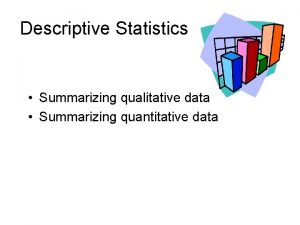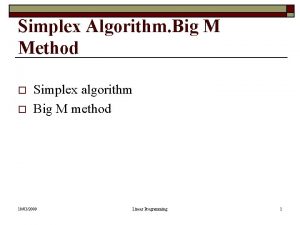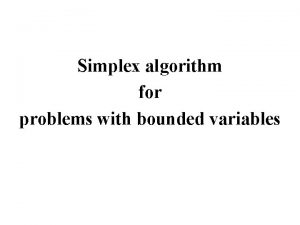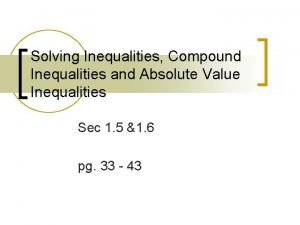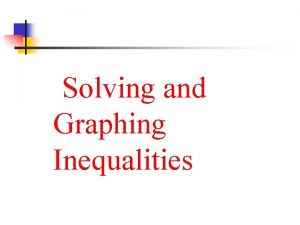Simplex Algorithm Fluency Summarise inequalities into a simplex



















- Slides: 19


+ Simplex Algorithm Fluency: Summarise inequalities into a simplex tableau Reasoning: Carry out the simplex algorithm using elimination method Key Words Problem Solving: Verify that you have an optimal solution Define the key words Variables Slack Feasible Optimal Pivot

Knowledge Check + Fluency A paper recycler has two processing plants. Plant A can process 4 tonnes of waste paper and 1 tonne of cardboard per hour. Plant B can process 5 tonnes of waste paper and 2 tonnes of cardboard per hour. It costs £ 400 per hour to run plant A and £ 600 per hour to run plant B. There is a union agreement that each plant must get at least one third of the run time of every consignment. A consignment of 100 tonnes of waste paper and 35 tonnes of cardboard must be shared between the plants so that costs are minimised. Write this as a linear programming formulation.

+ Knowledge Check - ANSWERS Fluency Waste paper Cardboard Cost Plant A (1 hour) 4 1 400 Plant B (1 hour) 5 2 600 Availability 100 35 n

+ Simplex Algorithm Reasoning n This is an algebraic method used to solve linear programming problems where there are three or more decision variables

The simplex algorithm ● Formulate the problem as a tableau ● Ensure that all elements in the last column (except possibly the top one) are non-negative ● Identify smallest value in top row to obtain pivot column ● Calculate θ = ‘value’ ÷ ‘pivot column’ for each row (except top row) ● Identify smallest non-negative θ to obtain pivot (the number in the pivot column) ● Divide row identified by pivot to obtain pivot row, shown in new table ● Combine appropriate multiples of all other rows with the pivot row in order to make all other elements in the pivot column zero ● If all values in the top row are non-negative, an optimal solution has been found. If not, repeat steps above.

Consider this linear programming problem: Maximise Subject to: This cannot be represented by a graph as there are 3 variables We solve problems like this using the Simplex Algorithm, created in 1947. It has become an invaluable, contemporary tool in microeconomics, company management and operational research, all of which are concerned with making decisions about how to allocate limited resources.

As inequalities As equations And P = 35 x + 55 y + 60 z can be re-written as: P – 35 x – 55 y – 60 z = 0 These equations then need putting into a tableau: P x z r s t Value -35 y -55 1 0 -60 0 0 7 10 10 1 0 0 3600 0 6 9 12 0 1 0 2 3 4 0 0 0 1 3600 2400

+ Simplex Algorithm Reasoning n Complete the simplex practice sheet

P x R 2 1 0 R 3 R 4 R 1 θ z r s t Value -35 y -55 -60 0 0 7 10 10 1 0 0 360 0 6 9 12 0 1 2 3 4 0 0 3600 2400 300 0 0 1 600 Pivot column P x y z r s t Value R 5 1 -5 -10 0 0 5 0 18000 R 1 +60 R 7 R 6 0 2 2. 5 0 1 -10/12 0 600 R 7 R 8 0 1/2 3/4 1 0 0 300 0 0 1/12 -1/3 1 1200 R 4 -4 R 7 R 2 -10 R 7 ● Identify ●●If. Combine smallest multiples θ to ofobtain allto other pivot rows (the with number the pivot in the ● allrow values in non-negative the by top row non-negative, an optimal Calculate θidentified =appropriate ‘value’ ÷ pivot ‘pivot column’ for each row (except top row) Identify smallest value in are top row obtain pivot column ●● Divide to obtain pivot row, shown in new table pivot row column) in order to make all other elements in the pivot column zero solution has been found. If not, repeat steps above.

P x y z r s t Value R 5 1 -5 -10 0 0 5 0 18000 R 6 0 2 2. 5 0 1 -10/12 0 600 240 R 7 R 8 0 1/2 3/4 1 0 0 300 400 0 0 1/12 -1/3 1 1200 P x y z r s t Value R 9 1 3 0 0 5/3 0 R 10 4/5 0 -1/3 0 -1/10 1 0 20400 R 5 +10 R 10 240 R 6 /2. 5 R 11 0 0 4 2/5 0 0 -3/10 0 1/3 R 12 1 0 -1/3 1 Max P = 20400, this would be when x = r = s = 0 z = 120 (t = 1200)- there is still slack ∞ 120 R 7 -3/4 R 10 1200 R 8 P + 3 x + 4 r + 5/3 s = 20400 y = 240 θ






+ Simplex Algorithm Problem Solving n Complete the simplex exam questions

+ Plenary – State your confidence with each skill A. Use slack variables to write a linear programming problem as a simplex tableau B. Solve a maximisation problem using the simplex algorithm C. Convert a minimisation problem to a maximisation problem and solve it using the simplex algorithm What will you do to improve?

+ Homework Complete exercise 3. 3 and self assess
 Summarise types of early years provision
Summarise types of early years provision Reading vipers inference
Reading vipers inference Descriptive statistics for qualitative data
Descriptive statistics for qualitative data Douglas theory on group living
Douglas theory on group living Quote summarizer
Quote summarizer Summarise the poem “a mother in a refugee camp”
Summarise the poem “a mother in a refugee camp” Valentine poem summary
Valentine poem summary Vipers summarise
Vipers summarise Realism vs anti realism
Realism vs anti realism Simplex algorithm example
Simplex algorithm example Network simplex algorithm
Network simplex algorithm What are the basic steps involved in the simplex algorithm?
What are the basic steps involved in the simplex algorithm? Simplex algorithm runtime
Simplex algorithm runtime Stages of learning acquisition maintenance generalization
Stages of learning acquisition maintenance generalization Stages of second language development
Stages of second language development What is sentence fluency
What is sentence fluency Woodcock johnson test of achievement iv
Woodcock johnson test of achievement iv Definition of reading fluency
Definition of reading fluency Six dimensions fluency rubric
Six dimensions fluency rubric In the poem watch me grow to what is reading compared
In the poem watch me grow to what is reading compared


